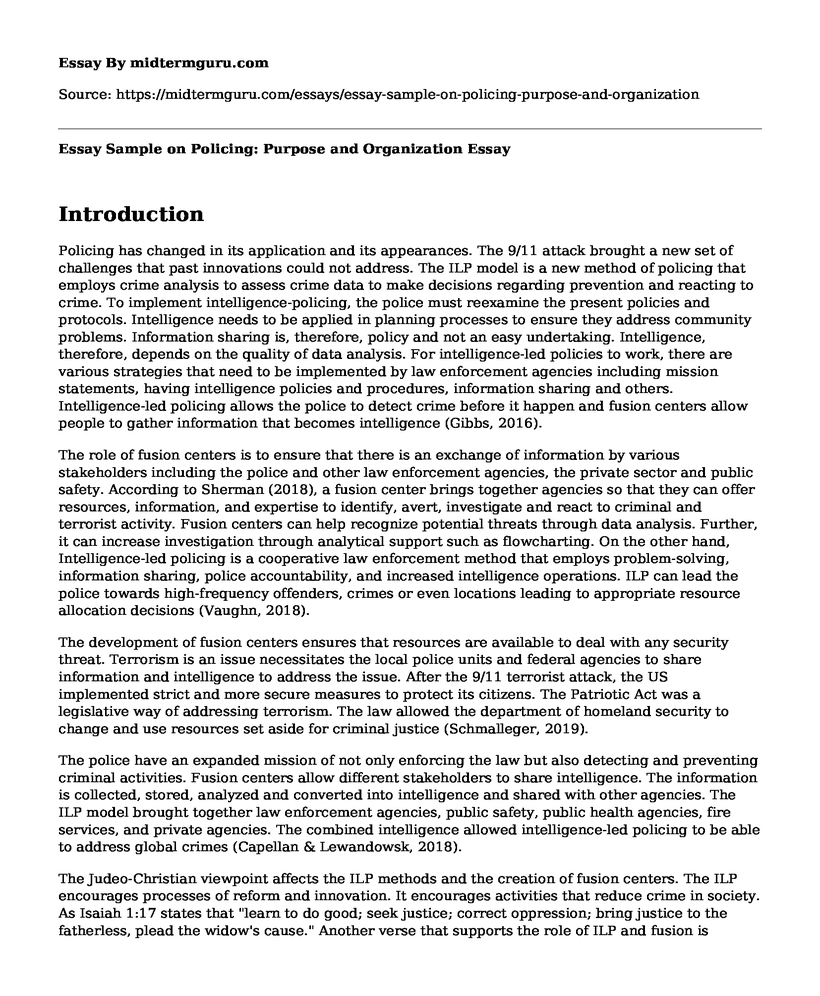Introduction
Policing has changed in its application and its appearances. The 9/11 attack brought a new set of challenges that past innovations could not address. The ILP model is a new method of policing that employs crime analysis to assess crime data to make decisions regarding prevention and reacting to crime. To implement intelligence-policing, the police must reexamine the present policies and protocols. Intelligence needs to be applied in planning processes to ensure they address community problems. Information sharing is, therefore, policy and not an easy undertaking. Intelligence, therefore, depends on the quality of data analysis. For intelligence-led policies to work, there are various strategies that need to be implemented by law enforcement agencies including mission statements, having intelligence policies and procedures, information sharing and others. Intelligence-led policing allows the police to detect crime before it happen and fusion centers allow people to gather information that becomes intelligence (Gibbs, 2016).
The role of fusion centers is to ensure that there is an exchange of information by various stakeholders including the police and other law enforcement agencies, the private sector and public safety. According to Sherman (2018), a fusion center brings together agencies so that they can offer resources, information, and expertise to identify, avert, investigate and react to criminal and terrorist activity. Fusion centers can help recognize potential threats through data analysis. Further, it can increase investigation through analytical support such as flowcharting. On the other hand, Intelligence-led policing is a cooperative law enforcement method that employs problem-solving, information sharing, police accountability, and increased intelligence operations. ILP can lead the police towards high-frequency offenders, crimes or even locations leading to appropriate resource allocation decisions (Vaughn, 2018).
The development of fusion centers ensures that resources are available to deal with any security threat. Terrorism is an issue necessitates the local police units and federal agencies to share information and intelligence to address the issue. After the 9/11 terrorist attack, the US implemented strict and more secure measures to protect its citizens. The Patriotic Act was a legislative way of addressing terrorism. The law allowed the department of homeland security to change and use resources set aside for criminal justice (Schmalleger, 2019).
The police have an expanded mission of not only enforcing the law but also detecting and preventing criminal activities. Fusion centers allow different stakeholders to share intelligence. The information is collected, stored, analyzed and converted into intelligence and shared with other agencies. The ILP model brought together law enforcement agencies, public safety, public health agencies, fire services, and private agencies. The combined intelligence allowed intelligence-led policing to be able to address global crimes (Capellan & Lewandowsk, 2018).
The Judeo-Christian viewpoint affects the ILP methods and the creation of fusion centers. The ILP encourages processes of reform and innovation. It encourages activities that reduce crime in society. As Isaiah 1:17 states that "learn to do good; seek justice; correct oppression; bring justice to the fatherless, plead the widow's cause." Another verse that supports the role of ILP and fusion is Mathew 7:12 which states that whatever you wish that others would to you, also do to them, for this is the law and the prophets". The bible advocates for the protection of the poor and the weak in society. The law enforcement agencies have a role of working together and gathering intelligence regarding criminal activities and doing something to protect citizens against harm.
References
Capellan, J. A., & Lewandowski, C. (2018). Can threat assessment help police prevent mass public shootings? Testing an intelligence-led policing tool. Policing: An International Journal.
Gibbs, C. (2016). Addressing Transnational Environmental Crime: The Role of Intelligence-Led Policing. In Environmental Crime in Transnational Context (pp. 101-116). Routledge.
Schmalleger, F. (2019). Criminal Justice Today: An Introductory Text for the 21st Century,14e
Sherman, L. W. (2018). Evidence-based policing: Social organization of information for social control. In Crime and social organization (pp. 235-266). Routledge.
Vaughn, S. (2018). Intelligence-Led Policing: An Improvement for Law Enforcement and the Community.
Pearsoncmg. (2019) An Introduction to Today's Terrorism. Media.pearsoncmg.com. Retrieved 20 January 2019, from http://media.pearsoncmg.com/pcp/pls_1256312665/mcl_inv16/mcl_inv16.html
Cite this page
Essay Sample on Policing: Purpose and Organization. (2022, Nov 07). Retrieved from https://midtermguru.com/essays/essay-sample-on-policing-purpose-and-organization
If you are the original author of this essay and no longer wish to have it published on the midtermguru.com website, please click below to request its removal:
- Annotated Bibliography: Police Brutality
- Why Some Hackers Are Successful in Phishing - Paper Example
- Grassroots Groups Unite to Champion Rights of Local Communities in US - Research Paper
- Should Marijuana Be Legalized? - Essay Sample
- The American Nurse Association (ANA) and its Effectiveness - Essay Sample
- Strategic Plan: Scottsdale Police Department 2021-2024 - Essay Sample
- Juveniles Should Be Tried as Adults - Argumentative Essay







